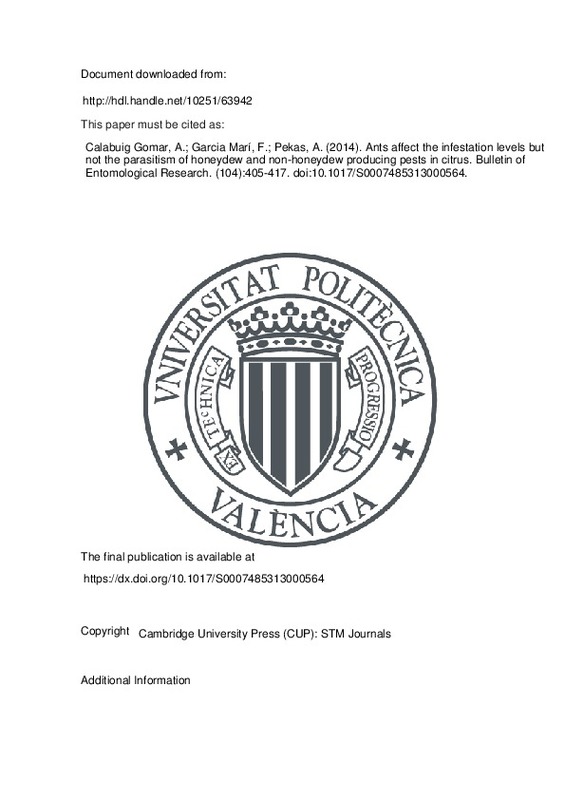JavaScript is disabled for your browser. Some features of this site may not work without it.
Buscar en RiuNet
Listar
Mi cuenta
Estadísticas
Ayuda RiuNet
Admin. UPV
Ants affect the infestation levels but not the parasitism of honeydew and non-honeydew producing pests in citrus
Mostrar el registro sencillo del ítem
Ficheros en el ítem
| dc.contributor.author | Calabuig Gomar, Altea
|
es_ES |
| dc.contributor.author | García Mari, Ferran
|
es_ES |
| dc.contributor.author | Pekas, Apostolos
|
es_ES |
| dc.date.accessioned | 2016-05-12T06:26:41Z | |
| dc.date.available | 2016-05-12T06:26:41Z | |
| dc.date.issued | 2014-08 | |
| dc.identifier.issn | 0007-4853 | |
| dc.identifier.uri | http://hdl.handle.net/10251/63942 | |
| dc.description.abstract | [EN] Ants act simultaneously as predators and as hemipteran mutualists, and thereby may affect the composition and population dynamics of a wide arthropod community. We conducted ant-exclusion experiments in order to determine the impact of ants on the infestation levels and parasitism of three of the most important citrus pests of western Mediterranean citrus: the honeydew producer Aleurothrixus floccosus Maskell (woolly whitefly) and the non-honeydew producers Aonidiella aurantii Maskell (California red scale; CRS) and Phyllocnistis citrella (Staiton) (citrus leafminer). The study was conducted in three commercial citrus orchards, each one dominated by one ant species (Pheidole pallidula, Lasius grandis or Linepithema humile) during two consecutive growing seasons (2011 and 2012). We registered a significant reduction of the CRS densities on fruits in the ant-excluded treatment in the three orchards and in the two seasons, ranging from as high as 41% to as low as 21%. Similarly, the percentage of shoots occupied by A. floccosus was significantly lower in the ant-excluded plots in the orchards dominated by P. pallidula and L. humile. No significant differences were registered in the percentage of leaf surface loss caused by P. citrella between ant-allowed and ant-excluded treatments in any case. We found no significant differences in the percent parasitism between ant-allowed and ant-excluded treatments for honeydew and non-honeydew producing herbivores. These results suggest that: (i) ant management should be considered in order to reduce herbivore populations in citrus and (ii) mechanisms other than parasitism (e.g., predation) might explain the differences in herbivore infestation levels between treatments. | es_ES |
| dc.description.sponsorship | This work was supported by the project (RTA2010-00012-C02-02) assigned to F. G. M from the Instituto Nacional de Investigacion y Tecnologia Agraria y Alimentaria (INIA) of Spain. We thank three reviewers for their comments that considerably improved the manuscript. | en_EN |
| dc.language | Inglés | es_ES |
| dc.publisher | Cambridge University Press (CUP): STM Journals | es_ES |
| dc.relation.ispartof | Bulletin of Entomological Research | es_ES |
| dc.rights | Reserva de todos los derechos | es_ES |
| dc.subject | Lasius grandis | es_ES |
| dc.subject | Pheidole pallidula | es_ES |
| dc.subject | Linepithema humile | es_ES |
| dc.subject | Aonidiella aurantii | es_ES |
| dc.subject | Aleurothrixus floccosus | es_ES |
| dc.subject | Phyllocnistis citrella | es_ES |
| dc.subject.classification | PRODUCCION VEGETAL | es_ES |
| dc.title | Ants affect the infestation levels but not the parasitism of honeydew and non-honeydew producing pests in citrus | es_ES |
| dc.type | Artículo | es_ES |
| dc.identifier.doi | 10.1017/S0007485313000564 | |
| dc.relation.projectID | info:eu-repo/grantAgreement/MICINN//RTA2010-00012-C02-02/ES/Influencia de las hormigas en las poblaciones de artrópodos fitófagos y sus enemigos naturales en parcelas de cítricos/ | es_ES |
| dc.rights.accessRights | Abierto | es_ES |
| dc.contributor.affiliation | Universitat Politècnica de València. Departamento de Ecosistemas Agroforestales - Departament d'Ecosistemes Agroforestals | es_ES |
| dc.description.bibliographicCitation | Calabuig Gomar, A.; García Mari, F.; Pekas, A. (2014). Ants affect the infestation levels but not the parasitism of honeydew and non-honeydew producing pests in citrus. Bulletin of Entomological Research. (104):405-417. https://doi.org/10.1017/S0007485313000564 | es_ES |
| dc.description.accrualMethod | S | es_ES |
| dc.relation.publisherversion | https://dx.doi.org/10.1017/S0007485313000564 | es_ES |
| dc.description.upvformatpinicio | 405 | es_ES |
| dc.description.upvformatpfin | 417 | es_ES |
| dc.type.version | info:eu-repo/semantics/publishedVersion | es_ES |
| dc.description.issue | 104 | es_ES |
| dc.relation.senia | 280421 | es_ES |
| dc.identifier.eissn | 1475-2670 | |
| dc.contributor.funder | Ministerio de Ciencia e Innovación | es_ES |







![[Cerrado]](/themes/UPV/images/candado.png)

